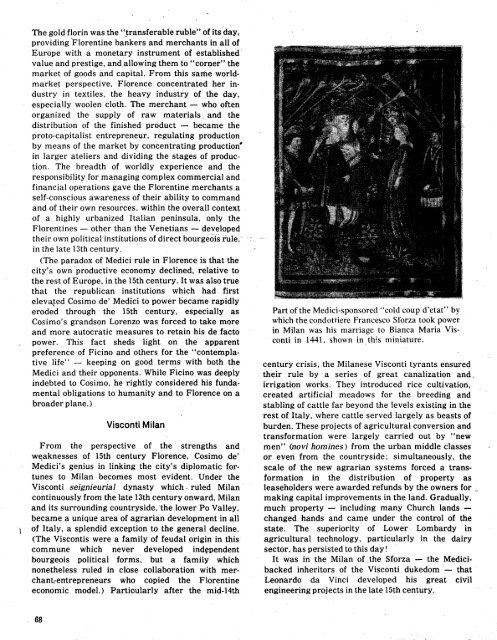Renaissance and
Renaissance and
Renaissance and
Create successful ePaper yourself
Turn your PDF publications into a flip-book with our unique Google optimized e-Paper software.
The gold florin was the "transferable ruble" of its day,<br />
providing-Florentine bankers <strong>and</strong> merchants in all of<br />
Europe with a monetary instrument of established<br />
value <strong>and</strong> prestige, <strong>and</strong> allowing them to "cornet"' the<br />
market of goods <strong>and</strong> capital. From this same worldmarket<br />
perspective, Florence concentrated her industry<br />
in textiles, the heavy industry of the day,<br />
especially woolen cloth. The merchant -- who often<br />
organize d the supply of raw materials <strong>and</strong> the<br />
distribution of the finished product -- became the<br />
proto-capitalist entrepreneur, regulating production<br />
by means of the market by concentrating production"<br />
in larger ateliers <strong>and</strong> dividing the stages of production.<br />
The breadth of worldly experience <strong>and</strong> the<br />
responsibil!ty for managing complex commercial <strong>and</strong><br />
financial operations gave the Florentine merchants a<br />
self-conscious awareness of their ability to comm<strong>and</strong><br />
<strong>and</strong> of their own resources, within the overall context<br />
of a highly urbanized Italian peninsula, only the<br />
Florentines -- other than the Venetians -- developed<br />
their own political institutions of direct bourgeois rule, :<br />
in the late 13th century.<br />
(The paradox of Medici rule in Florence is that the<br />
city's own 'productive economy declined, relative to<br />
the rest of Europe, in the 15th century. It was also true<br />
that the republican institutions which had first<br />
elevated Cosimo de' Medici to power became rapidly<br />
eroded through the 15th century, especially as Part oftheMedici-sponsored"coldcoupd'etat"by<br />
Cosimo's gr<strong>and</strong>son Lorenzo was forced to take more which the condottiere Francesco Sforza took power<br />
<strong>and</strong> more autocratic measures to retain his de facto in Milan was his marriage to Bianca Maria Vispower.<br />
This fact sheds light on the apparent conti in 1441, shown in this miniature.<br />
preference of Ficino <strong>and</strong> others for the "contemplative<br />
life" -- keeping on good terms with both the century crisis, the Milanese Visconti tyrants ensured<br />
Medici <strong>and</strong> their opponents. While Ficino was deeply their rule by a series of great canalization <strong>and</strong>,<br />
indebted to Cosimo, he rightly considered his funda- irrigation works. They introduced rice cultivation,<br />
mental obligations tO humanity <strong>and</strong> to Florence on a created artificial meadows for the breeding <strong>and</strong><br />
broader plane.) stabling of cattle far beyond the levels existing in the<br />
rest of Italy, where cattle served largely as beasts of<br />
Visconti Milan burden. These projects of agricultural conversion <strong>and</strong><br />
transformation were largely carried out by "new<br />
From the perspective of the strengths <strong>and</strong> men" (novi homines) from the urban middle classes<br />
we.aknesses of 15th century Florence, Cosimo de' or even from the countryside; simultaneously, the<br />
Medici's genius in linking the city's diplomatic for- scale of the new agrarian systems forced a transtunes<br />
to Milan becomes most evident. Under the formation in the distribution of property as<br />
Visconti seignieurial dynasty which, ruled Milan leaseholders were awarded refunds by the owners for _<br />
continuously from the late 13th century onward, Milan making capital improvements in the l<strong>and</strong>. Gradually,<br />
<strong>and</strong> its surrounding countryside, the lower Po Valley: much property -- including many Church l<strong>and</strong>s --<br />
became a unique area of agrarian development in all changed h<strong>and</strong>s <strong>and</strong> came under the control of the<br />
of Italy, a splendid exception to the general decline, state. The superiority of Lower Lombardy in<br />
(The Viscontis were a family of feudal origin in this agricultural technology, particularly in the dairy<br />
commune which never developed independent sector, has persisted to this day!<br />
bourgeois political forms, but a family which It was in the Milan of the Sforza -- the Medicinonetheless<br />
ruled in close collaboration with mer- backed inheritors•of the Visconti dukedom -- that<br />
chant:entrepreneurs who copied the Florentine Le0nardo da Vinci developed his great civil<br />
economic model.) Partioularly after the mid-14th engineering projects in the late 15th century.<br />
68

















